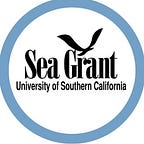Pioneering marine science for women
Dorothy Soule, an important player in USC Sea Grant’s early history
By Charlotte Stevenson, Science Writer, USC Sea Grant
In honor of Women’s History Month, we are celebrating Dr. Dorothy Soule, a woman who was a huge part of USC Sea Grant’s early history and was a pioneer in marine science at a time when very few women were in the field.
Believe it or not, women were not allowed to sail on oceanographic vessels until the 1960s! A female graduate student was dismissed from Woods Hole Oceanographic Institution in Massachusetts in 1956 when she attempted to get on a vessel for research, and it was only in 1963 that Scripps Institution of Oceanography in San Diego broke this tradition, allowing Elena Lubimova, a heat flow geophysicist, onboard a vessel. Soon following, Dorothy Soule entered the marine science world in California.
Dorothy Soule, previously Dorothy Louise Fisher, grew up in Cleveland, Ohio, and received a B.S. with honors in Zoology from Miami University in Ohio. She met John Soule in a Biology laboratory there, the two were married in 1943, and they headed west and never looked back. While John served in the Pacific theatre during WWII, Dorothy became a research associate at the University of Southern California.
Dorothy Soule became involved with Sea Grant almost from its birth. Sea Grant began its life in February 1967, and one year later, the first Sea Grant awards were made to Massachusetts Institute of Technology, California Institute of Technology, and Louisiana’s Nicholls State College. In 1970, Sea Grant was transferred from the National Science Foundation to the brand new National Oceanic and Atmospheric Administration (NOAA) under the Department of Commerce. USC began to receive Sea Grant funding in 1970, and Dorothy Soule was among some of the first researchers to receive funding in 1971. USC Sea Grant was established in 1972 as one of the first 7 full Sea Grant College programs.
Dorothy fell in love with an entire phylum of animals, Bryozoa, which most of us have no idea exists. What is a bryozoan? More commonly known as “moss animals,” they are very tiny (averaging 1/64 inch) animals that filter nutrients out of the water with tiny tentacles and usually live in colonies. They are eaten by animals like sea slugs, sea urchins, and sea stars. Dorothy is credited for discovering many new species of bryozoans! And, according to other Sea Grant staff, Dorothy seemed to spend just as much time in boats as she did on land, further solidifying women’s full-throttle move into ship-based research after their historical ban before the 1960s.
Dorothy earned her Masters from Occidental College in Los Angeles and her Ph.D. from Claremont Graduate School. John Soule earned his Ph.D. from USC after returning from the war, and the two of them published many papers together on bryozoans, which often included Dorothy’s own intricate scientific illustrations.
In addition to her USC Sea Grant research, Dorothy had a number of other important leadership roles over the years. She was the curator of the Bryozoa collection in the Allan Hancock Foundation at USC, the Director of the Harbors Environmental Project, a member of the Environmental Protection Agency Science Advisory Board, a member of the marine fisheries advisory council for NOAA, a member of the marine ecosystem monitoring task group of National Academies of Sciences/National Research Council, a member of the Fish Harbor planning subcommittee in the Port of Los Angeles, a member of the NOAA Task Force on Marine Pollution monitoring in the Pacific region and Chairman of the Anchovy Subpanel of the Pacific Fishery Management Council.
Dorothy kept working on her research at USC until weeks before her death from cancer in 2005 at age 81. We often hear about more famous female pioneers in the history of marine science, like scientist and writer, Rachel Carson, and Her Deepness, Dr. Sylvia Earle. However, we often don’t hear about the women, like Dr. Dorothy Soule, who were prolific researchers and leaders in marine science in the decades when very few women were.
Today, women make up at least half and often more than half of Sea Grant leadership, staff, fellows, and researchers. USC Sea Grant’s current Director, Dr. Linda Duguay, is currently the longest female serving Director of the 34 Sea Grant programs! Like a single bryozoan that lands on a kelp blade and then multiplies into a colony in the thousands, you could say that Dorothy was a pioneer, paving the way for 1,000’s of more women.
Sources:
-National Sea Grant Library
-USC News. 2003. “ The Birds and Bees and the Flowers and the Trees.”
- Soule Kindred Newsletter, Vol. Xxxxx, №1, June/July 2006
-Prabook. “ Dorothy Fisher Soule.”
-Bonatti, Enrico, and Kathleen Crane. “Oceanography and Women: Early Challenges.” Oceanography, vol. 25, no. 4, 2012, pp. 32–39.
Media Contact: Leah Shore / lshore@usc.edu / (213)-740–1960
Originally published at https://dornsife.usc.edu on August 27, 2020
